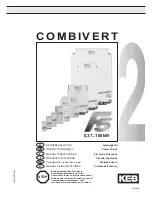
DAC1006/1007/1008 — Simple
Hookup for a “Quick Look”
(Continued)
the implementation of the PUSH instruction which will output
the higher order byte of the register pair (i.e., register B of the
BC pair) first. The DAC will actually appear as a two-byte
“stack” in memory to the CPU. The auto-decrementing of the
stack pointer during a PUSH allows using address bit 0 of
the stack pointer as the Byte1/Byte2 and XFER strobes if bit
0 of the stack pointer address −1, (SP−1), is a “1” as pre-
sented to the DAC. Additional address decoding by the
DM8131 will generate a unique DAC chip select (CS) and
synchronize this CS to the two memory write strobes of the
PUSH instruction.
To reset the stack pointer so new data may be output to the
same DAC, a POP instruction followed by instructions to in-
sure that proper data is in the DAC data register pair before
it is “PUSHED” to the DAC should be executed, as the POP
instruction will arbitrarily alter the contents of a register pair.
Another double byte write instruction is Store H and L Direct
(SHLD), where the HL register pair would temporarily con-
tain the DAC data and the two sequential addresses for the
DAC are specified by the instruction op code. The auto incre-
menting of the DAC address by the SHLD instruction permits
the same simple scheme of using address bit 0 to generate
the byte number and transfer strobes.
7.2 DAC1006 to MC6820/1 PIA Interface
In
Figure 19 the DAC1006 is interfaced to an M6800 system
through an MC6820/1 Peripheral Interface Adapter (PIA). In
this case the CS pin of the DAC is grounded since the PIA is
already mapped in the 6800 system memory space and no
decoding is necessary. Furthermore, by using both Ports A
and B of the PIA the 10-bit data transfer, assumed left justi-
fied again in two 8-bit bytes, is greatly simplified. The HIGH
byte is loaded into Output Register A (ORA) of the PIA, and
the LOW byte is loaded into ORB. The 10-bit data transfer to
the DAC and the corresponding analog output change occur
simultaneously upon CB2 going LOW under program con-
trol. The 10-bit data word in the DAC register will be latched
(and hence V
OUT
will be fixed) when CB2 is brought back
HIGH.
If both output ports of the PIA are not available, it is possible
to interface the DAC1006 through a single port without much
effort. However, additional logic at the CB2(or CA2) lines or
access to some of the 6800 system control lines will be re-
quired.
7.3 Noise Considerations
A typical digital/microprocessor bus environment is a tre-
mendous potential source of high frequency noise which can
be coupled to sensitive analog circuitry. The fast edges of the
data and address bus signals generate frequency compo-
nents of 10’s of megahertz and can cause noise spikes to
appear at the DAC output. These noise spikes occur when
the data bus changes state or when data is transferred be-
tween the latches of the device.
In low frequency or DC applications, low pass filtering can
reduce these noise spikes. This is accomplished by
over-compensating the DAC output amplifier by increasing
the value of the feedback capacitor (C
C
in
Figure 3 ).
In applications requiring a fast transient response from the
DAC and op amp, filtering may not be feasible. Adding a
latch, DM74LS374, as shown in
Figure 20 isolates the de-
vice from the data bus, thus eliminating noise spikes that oc-
DS005688-24
NOTE: DOUBLE BYTE STORES CAN BE USED.
e.g. THE INSTRUCTION SHLD F001 STORES THE L REG INTO B1 AND THE H REG INTO B2 AND TRANSFERS THE RESULT TO THE DAC REGISTER.
THE OPERAND OF THE SHLD INSTRUCTION MUST BE AN ODD ADDRESS FOR PROPER TRANSFER.
FIGURE 18. Interfacing the DAC1000 to the INS8080A CPU Group
www.national.com
19
PrintDate=1998/11/17 PrintTime=11:38:10 46711 ds005688 Rev. No. 4
cmserv
Proof
19






































